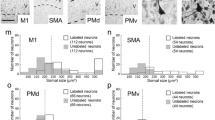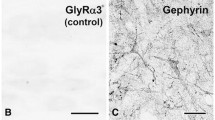Abstract
The dendritic tree constitutes more than 93% of the receptive membrane area of a spinal motoneuron, yet little is known about its synaptic inputs. In this study we examined the distribution of glutamate-, GABA- and glycine-like immunoreactivity in boutons apposing dendrites in the L7 spinal cord motor nucleus, by use of postembedding immunohistochemistry on serial sections.
We examined 799 boutons apposing 401 cross-sectioned dendrites of different calibre (range 0.2–15 µm), and 14 first-order (stem) dendrites. Thirty-five percent (35%) of the boutons were immunopositive for glutamate and 59% for GABA and/or glycine. Among the latter, 30% showed glycine immunoreactivity only and 24% were immunoreactive for both GABA and glycine. Very few were immunoreactive only for GABA (5%). As few as 6% of the boutons were judged as not enriched for any amino acid analysed. The fine structural characteristics of the boutons were in accordance with previous descriptions. The sample of dendrites was arranged in calibre bins in order to facilitate distribution analysis. Stem dendrites differed from the other bins, with a high total bouton covering (61%) and a high bouton density. Sixty-nine percent of the membrane covering was by glycine- and/or GABA-immunoreactive boutons, whereas 18% was covered by boutons enriched in glutamate. For non-stem dendrites, bouton covering fell from 33% to 12% with decreasing calibre. However, bouton apposition length decreased in parallel, yielding a fairly uniform bouton density among dendrites of different calibre. The lack of correlation between packing density and dendrite calibre was also evident when the sample of dendrites was broken down into subsamples based on content of amino acid immunoreactivity. The latter analysis also revealed that both the relative covering and density of boutons containing inhibitory amino acids (57%; glycine and/or GABA) and glutamate (38%), respectively, did not vary systematically with dendrite calibre. Combined, the data indicate that in non-stem dendrites the proportion of excitatory and inhibition inputs does not change systematically throughout the dendritic arborizations of spinal α-motoneurons. Thus, spinal motoneurons can, with respect to the general synaptic architecture, be divided into two main compartments, i.e. the proximal soma-juxtasomatic compartment (including stem dendrites) and the distal dendritc compartment. The proximal domain is under a powerful glycine and/or GABA influence. Finally, based on the data presented here and previously published data, it was calculated that spinal α-motoneurons receive in the range of 50–140×103 synaptic boutons.
Similar content being viewed by others
Author information
Authors and Affiliations
Additional information
Received: 26 March 1997 / Accepted: 10 June 1997
Rights and permissions
About this article
Cite this article
Örnung, G., Ottersen, O., Cullheim, S. et al. Distribution of glutamate-, glycine- and GABA-immunoreactive nerve terminals on dendrites in the cat spinal motor nucleus. Exp Brain Res 118, 517–532 (1998). https://doi.org/10.1007/s002210050308
Issue Date:
DOI: https://doi.org/10.1007/s002210050308




